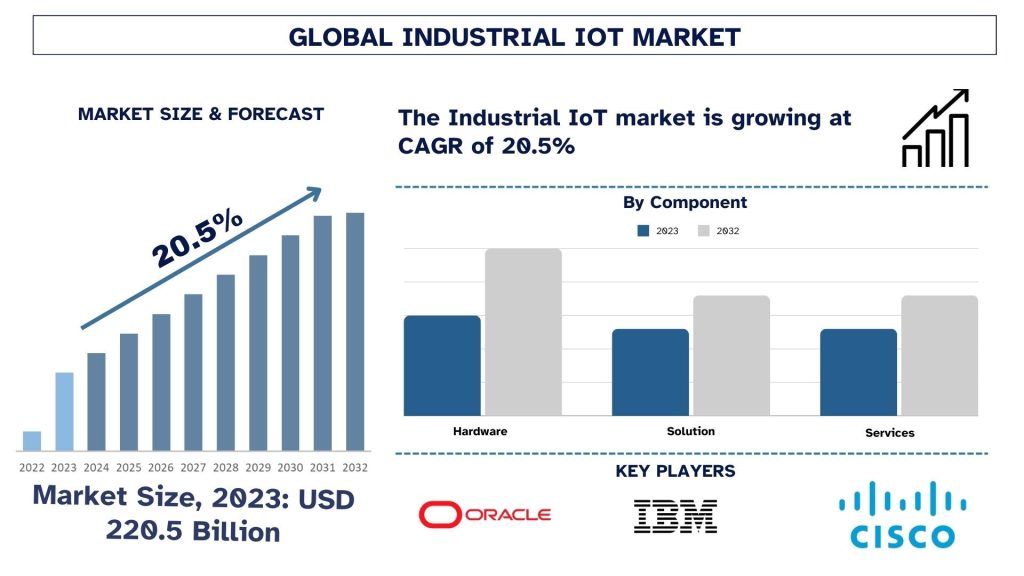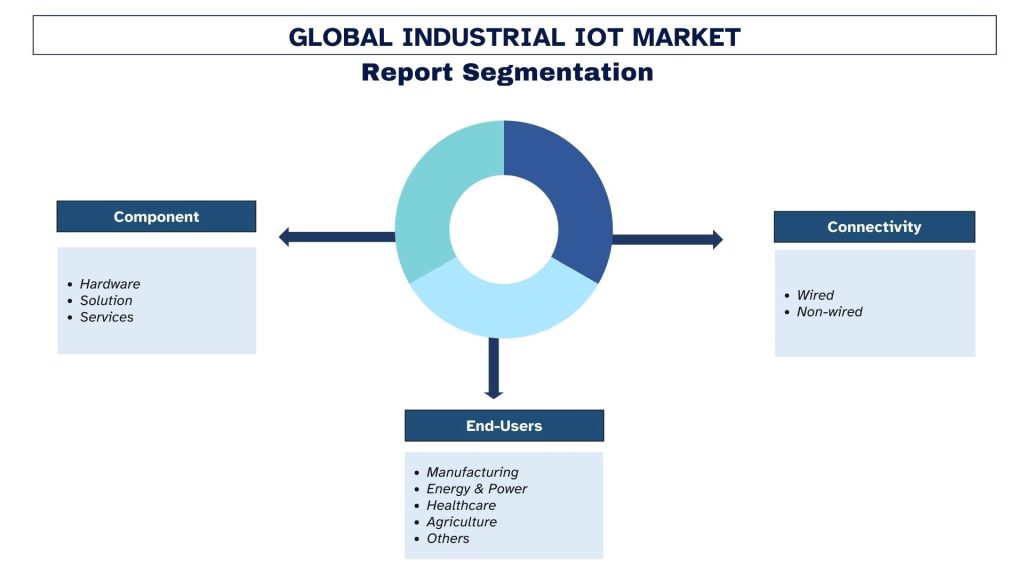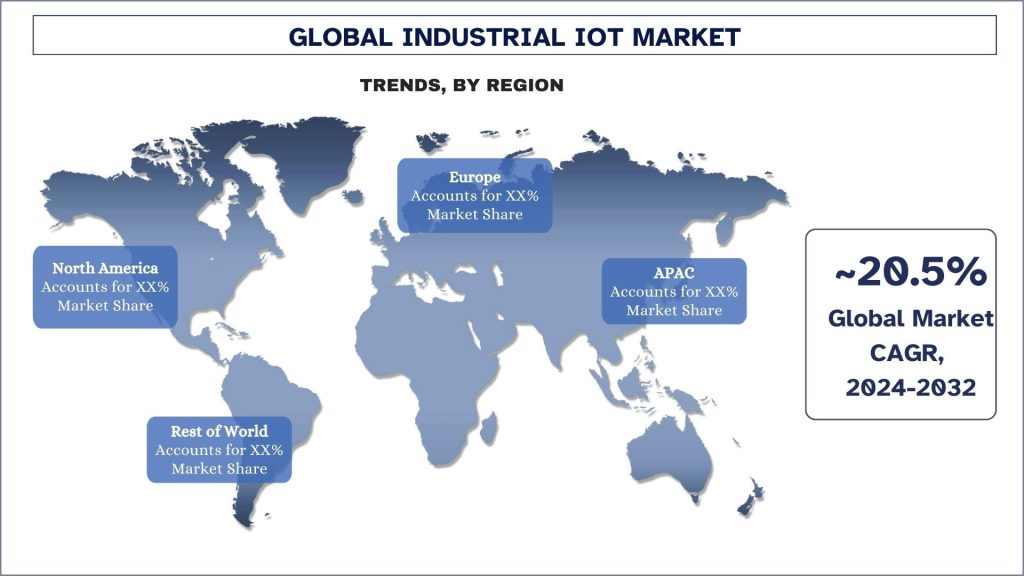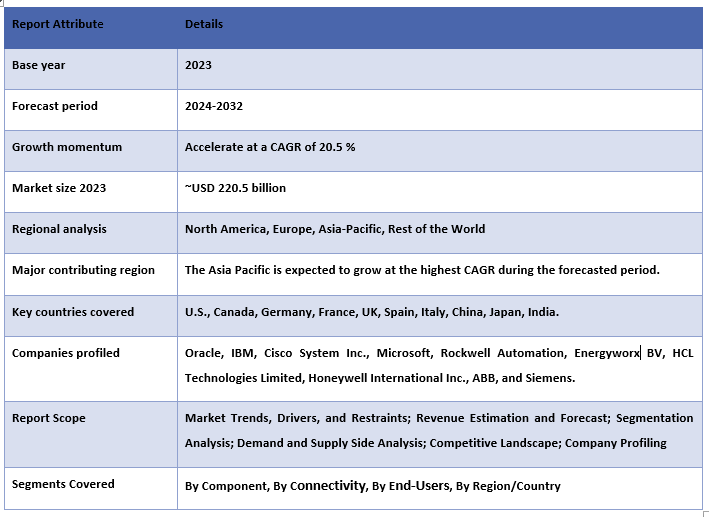Industrial IoT Market: Current Analysis and Forecast (2024-2032)
$3999 – $6999
Emphasis on components (Hardware, Solution, and Service); Connectivity (Wired and Non-Wired); End-users (Manufacturing, Energy & Power, Healthcare, Agriculture, and Other); and Region/Country
| Pages: | 154 |
|---|---|
| Table: | 44 |
| Figure: | 104 |
| Report ID: | UMTI211199 |
| Geography: |

Report Description
Industrial IoT Market Size & Forecast
The Industrial IoT market was valued at approximately USD 220.5 Billion in 2023 and is expected to grow at a robust CAGR of around 20.5% during the forecast period (2024-2032). The growth of the Industrial IoT market is driven by increasing demand for automation, real-time data analytics, and enhanced operational efficiency across industries.
Industrial IoT Market Analysis
Industrial IoT is defined as the use of actuators and smart sensors to enhance manufacturing and production along with the improvement in the industrial process. Additionally, industrial IoT is often called industry 4.0 or industrial Internet and uses the power of real-time analytics and smart machines to provide effective and required results. In recent times, IoT in the industrial sector has seen significant growth owing to its ability to find the inefficiency and problems at an early stage and provide several benefits such as cost and time saving as well as control over quality and sustainable practices. In an industrial setting, IoT relates to the devices that collect, monitor, analyze, and exchange data. The connected devices can capture, sense, and store information and can analyze the effective output from the raw data.
Industrial IoT Market Trends
This section discusses the key market trends influencing the Industrial IoT segments as identified by our research experts.
Solution Component Transforming Industry
Based on components, the market is segmented into hardware, solutions, and services. The solution segment is expected to witness significant market growth during the forecast period on account of increasing overall equipment effectiveness, improved efficiency, and cost reduction through better access to the data from real-time solutions are supporting the growth of the solution segment. Also, the production process planning, optimization by the data collection, real-time monitoring, and sensor-generated data analysis are propelling the growth of the solution segment. Furthermore, the applicability of the solution segment in several industry verticals makes it more demanding than the other. For instance, the solution segment could be used in smart factories, asset monitoring, inventory management, machine maintenance, and predictive maintenance among others.
Asia-Pacific to hold a significant share in the market
In 2023, Asia-Pacific held a significant share of the global industrial IoT market. This is mainly due to the growing number of industries and better connectivity networks in the region. Additionally, the increasing population along with increasing research & development expenditure with the increasing number of local and international IT companies in the region are expected to support the industrial IoT market in the region. Also, the growing investment and increasing number of various industry verticals such as healthcare, manufacturing, and grid formation are creating the demand for industrial IoT in the region. Furthermore, the government takes several measures in the region to support Industry 4.0. For instance, in India, the government’s Industry 4.0 vision rests on four major principles including information transparency, interconnection, decentralized decision-making, and technical assistance.
Industrial IoT Industry Overview
Industrial IoT is competitive, with several global and international market players. The key players are adopting different growth strategies to enhance their market presence, such as partnerships, agreements, collaborations, new product launches, geographical expansions, and mergers and acquisitions. Some of the major players operating in the market are Oracle, IBM, Cisco System Inc., Microsoft, Rockwell Automation, Energyworx BV, HCL Technologies Limited, Honeywell International Inc., ABB, and Siemens. Several M&As along with partnerships have been undertaken by these players to facilitate customers with hi-tech and innovative products/technologies.
Industrial IoT Market News
For instance, in 2024, FOSSA Systems, a startup empowering global industries with accessible IoT and Space Technologies, announced it has raised a €6.3 million Series A round to grow its IoT satellite constellation focused on remote asset management for industrial use cases. The funding was co-led by Indico Capital Partners and Nabtesco Technology Ventures, with the participation of Newmind Venture and Sabadell Venture Capital.
Industrial IoT Market Report Coverage
Reasons to buy this report:
- The study includes market sizing and forecasting analysis validated by authenticated key industry experts.
- The report presents a quick review of overall industry performance at one glance.
- The report covers an in-depth analysis of prominent industry peers with a primary focus on key business financials, product portfolios, expansion strategies, and recent developments.
- Detailed examination of drivers, restraints, key trends, and opportunities prevailing in the industry.
- The study comprehensively covers the market across different segments.
- Deep dive regional level analysis of the industry.
Customization Options:
The Global Industrial IoT can further be customized as per the requirement or any other market segment. Besides this, UMI understands that you may have your own business needs; hence, feel free to connect with us to get a report that completely suits your requirements.
Frequently Asked Questions (FAQ)
Ans: The Global Industrial IoT market was valued at USD 220.5 Billion in 2023 and is expected to grow at a CAGR of 20.5% during the forecast period (2024-2032).
Ans: The growth of the Industrial IoT market is driven by increasing demand for automation, real-time data analytics, and enhanced operational efficiency across industries.
Ans: The solution segment has the largest Industrial IoT share by component.
Ans: Emerging trends in Industrial IoT include edge computing, AI-driven predictive maintenance, 5G connectivity, and digital twin technology for enhanced industrial efficiency.
Ans: Asia Pacific is expected to dominate the market in 2023. Q1: What is the global Industrial IoT's current size and growth potential?
Q2: What are the driving factors for the growth of global Industrial IoT?
Q3: Which segment has the largest share of the global Industrial IoT by component?
Q4: What are the emerging technologies and trends in global Industrial IoT?
Q5: Which region will dominate global Industrial IoT?

You can also purchase parts of this report. Do you want to check out a section wise
price list?
Research Methodology
Research Methodology for the Industrial IoT Market Analysis (2024-2032)
Analyzing the historical market, estimating the current market, and forecasting the future market of the global Industrial IoT market were the three major steps undertaken to create and analyze the adoption of Industrial IoT in major regions globally. Exhaustive secondary research was conducted to collect the historical market numbers and estimate the current market size. Secondly, numerous findings and assumptions were taken into consideration to validate these insights. Moreover, exhaustive primary interviews were also conducted, with industry experts across the value chain of the global Industrial IoT market. Post assumption and validation of market numbers through primary interviews, we employed a top-down/bottom-up approach to forecasting the complete market size. Thereafter, market breakdown and data triangulation methods were adopted to estimate and analyze the market size of segments and sub-segments of the industry. Detailed methodology is explained below:
Analysis of Historical Market Size
Step 1: In-Depth Study of Secondary Sources:
A detailed secondary study was conducted to obtain the historical market size of the Industrial IoT market through company internal sources such as annual reports & financial statements, performance presentations, press releases, etc., and external sources including journals, news & articles, government publications, competitor publications, sector reports, third-party database, and other credible publications.
Step 2: Market Segmentation:
After obtaining the historical market size of Industrial IoT, we conducted a detailed secondary analysis to gather historical market insights and share for different segments & sub-segments for major regions. Major segments are included in the report, such as component, connectivity, end-users, and region. Further country-level analyses were conducted to evaluate the overall adoption of testing models in that region.
Step 3: Factor Analysis:
After acquiring the historical market size of different segments and sub-segments, we conducted a detailed factor analysis to estimate the current market size of the Industrial IoT market. Further, we conducted factor analysis using dependent and independent variables such as component, connectivity, end-users, and Industrial IoT regions. A thorough analysis was conducted of demand and supply-side scenarios considering top partnerships, mergers and acquisitions, business expansion, and product launches in the Industrial IoT market sector across the globe.
Current Market Size Estimate & Forecast
Current Market Sizing: Based on actionable insights from the above three steps, we arrived at the current market size, key players in the global Industrial IoT market, and market shares of the segments. All the required percentage shares split and market breakdowns were determined using the above-mentioned secondary approach and were verified through primary interviews.
Estimation & Forecasting: For market estimation and forecast, weights were assigned to different factors including drivers & trends, restraints, and opportunities available for the stakeholders. After analyzing these factors, relevant forecasting techniques i.e., the top-down/bottom-up approach were applied to arrive at the market forecast for 2032 for different segments and sub-segments across the major markets globally. The research methodology adopted to estimate the market size encompasses:
The industry’s market size, in terms of revenue (USD) and the adoption rate of Industrial IoT across the major markets domestically
All percentage shares, splits, and breakdowns of market segments and sub-segments
Key players in the global Industrial IoT in terms of products offered. Also, the growth strategies adopted by these players to compete in the fast-growing market
Market Size and Share Validation
Primary Research: In-depth interviews were conducted with the Key Opinion Leaders (KOLs), including Top Level Executives (CXO/VPs, Sales Head, Marketing Head, Operational Head, Regional Head, Country Head, etc.) across major regions. Primary research findings were then summarized, and statistical analysis was performed to prove the stated hypothesis. Inputs from primary research were consolidated with secondary findings, hence turning information into actionable insights.
Split of Primary Participants in Different Regions
Market Engineering
The data triangulation technique was employed to complete the overall market estimation and to arrive at precise statistical numbers for each segment and sub-segment of the global Industrial IoT. Data was split into several segments and sub-segments after studying various parameters and trends in the component, connectivity, end-users, and regions of the global Industrial IoT market.
The main objective of the Global Industrial IoT Market Study
The current & future market trends of global Industrial IoT were pinpointed in the study. Investors can gain strategic insights to base their discretion for investments on the qualitative and quantitative analysis performed in the study. Current and future market trends determined the overall attractiveness of the market at a regional level, providing a platform for the industrial participant to exploit the untapped market to benefit from a first-mover advantage. Other quantitative goals of the studies include:
- Analyze the current and forecast market size of the Industrial IoT market in terms of value (USD). Also, analyze the current and forecast market size of different segments and sub-segments.
- Segments in the study include areas of component, connectivity, end-users, and regions.
- Define and analyze the regulatory framework for the Industrial IoT
- Analyze the value chain involved with the presence of various intermediaries, along with analyzing customer and competitor behaviors of the industry.
- Analyze the current and forecast market size of the Industrial IoT market for the major regions.
- Major countries of regions studied in the report include Asia Pacific, Europe, North America, and the Rest of the World
- Company profiles of the Industrial IoT market and the growth strategies adopted by the market players to sustain in the fast-growing market.
- Deep dive regional level analysis of the industry








